Monday, May 30. 2011
Local public transport
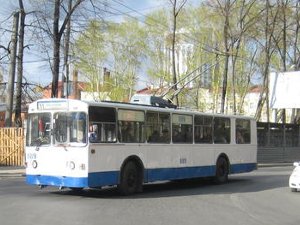 All russian cities we visited had a very well working public transport system. It consists of metros, trams, busses, trolleybusses and minibusses.
All russian cities we visited had a very well working public transport system. It consists of metros, trams, busses, trolleybusses and minibusses.On the metro, you pay for a coin (Yekaterinburg) or ticket (Moscow) before entering the area.
On Trams, you usually just get on the tram and there's a person where you can buy a ticket in the tram. It has a fixed price, which is usually between 10 and 20 rubels (about 0.25 to 0.50 €), if you need to switch the tram, you pay again. On busses, it's sometimes the same, if there's no person collecting ticket fees, you pay to the driver when leaving the bus. Same with trolleybusses and minibusses.
As long as you know which line to take, this is quite convenient. Usually, all lines come quite frequently, you only wait some minutes if you miss one. There was only one occasion where we had to take a taxi in Russia (to get the ferry to Port Baikal in time - the ferry itself worked like the trams, you pay on the ferry).
In Ulaanbaator, we found it a bit harder, mainly because we never really found out which bus to take (no tram or metro here). The ticket system is the same (you pay to a ticket seller on the bus). The busses here are often very overcrowded. Taxis here are really cheap, so that's what many people use.
Saturday, May 28. 2011
Bus from Ulan-Ude to Ulaanbaatar
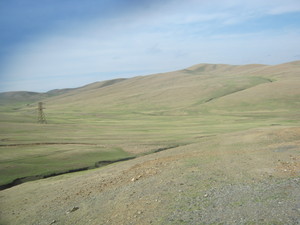 Ulan-Ude (Улан-Удэ) was our last stop in Russia, afterwards we took the bus to Ulaanbaatar (Улаанбаатар), the capital of Mongolia.
Ulan-Ude (Улан-Удэ) was our last stop in Russia, afterwards we took the bus to Ulaanbaatar (Улаанбаатар), the capital of Mongolia.I don't know why, but the mongolian part of the transsiberian railway is significantly more expensive than the russian part. The bus is a cheap alternative for the first part and it's also twice as fast (12 hours compared to 24 hours with the train). It costs 1000 rubels (about 25 €). We got the ticket through our hostel, so I can't tell where you can regularly buy it. (For the Mongolia-China part, there's also a cheap alternative, I'll write about that later.)
We started at 7 in the morning in Ulan-Ude. I'm usually a bit uncomfortable with long bus trips, especially if they go on curvy roads. Mongolia has nothing like motorways, so the whole ride goes on bumpy roads through the step.
Arriving at the russian-mongolian border, we had a bad feeling, because our migration card for russia was wrong. We got it at the border to Belarus and we didn't know that it's the migration card for both Belarus and Russia - so we only entered the dates and visa number for Belarus and realized that this was wrong when we entered Russia without a second border check. But it turned out our fear was unneccessary - the staff at the border called a colleague to look at the issue, but shortly afterwards we could go on without any more hassle.
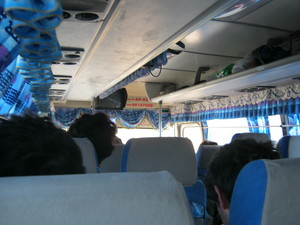 Right at the border, we already noticed that in Mongolia, english was much more common than in Russia. Unlike on the russian side, some of the mongolian border officers were able to speak english. After the border, we stopped at a restaurant for a while.
Right at the border, we already noticed that in Mongolia, english was much more common than in Russia. Unlike on the russian side, some of the mongolian border officers were able to speak english. After the border, we stopped at a restaurant for a while.Driving through the mongolian steppe, I felt that the main part of our journey really begins here: The landscape looked very different from everything I am used to and I found it quite exciting. Several times, the bus had to stop or horn for cows crossing the street.
In the evening, we arrived in Ulaanbaatar.
Pictures from Bus trip
Thursday, May 26. 2011
Ulan-Ude: Goodbye Lenin
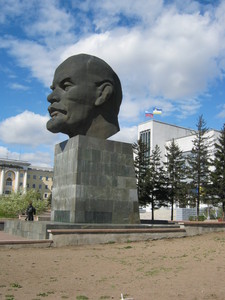 Ulan-Ude (Улан-Уд) is the city where the trans-Mongolian route of the transsiberian Train goes off the main route. Else, it's main sight is probably the big Lenin head statue, the biggest one in whole Russia.
Ulan-Ude (Улан-Уд) is the city where the trans-Mongolian route of the transsiberian Train goes off the main route. Else, it's main sight is probably the big Lenin head statue, the biggest one in whole Russia.Ulan-Ude is the capital of Buryatia. Buryats are people close to Mongolians, which one can easily see as many people look very different from most other russians.
We didn't do much there, except staying a night in a hostel and then leaving with a bus to Mongolia. So there is not much more to say about it.
Pictures from Ulan-Ude
Tuesday, May 24. 2011
Listwjanka and Port Baikal
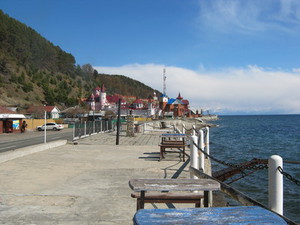 After being in Irkutsk, we headed on to lake Baikal. Although we heared that it's worthwile to visit the nature reserves in the north of the lake, we decided against it, as all options to get there would've involved quite long bus trips.
After being in Irkutsk, we headed on to lake Baikal. Although we heared that it's worthwile to visit the nature reserves in the north of the lake, we decided against it, as all options to get there would've involved quite long bus trips.Listwjanka (Листвянка) is a very tourist oriented village where the Angara River goes into lake Baikal. However, we were there completely out of season. I don't know if there was anyone else in the cheap Hotel we stayed, at least we saw noone else and the older couple running the Hotel seemed to be quite happy with having guests. This was the first time I stayed in a Hotel without any language communication possible.
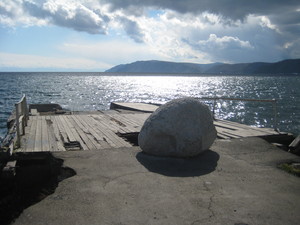 Listwjanka is connected with Port Baikal at the other side of the Angara with a ferry. Listwjanka is not very big, but it's spread several kilometers on the lake's shore. The ferry terminal was somewhat special. I wouldn't have noticed it as being in operation if I hadn't known exactly where it was. There was an old place to board the ferry where already some holes where in the ground and a big rock prevented any cars from getting on it. The ferry just boarded right beside that place. The timetable consisted of a piece of printed paper in plastic.
Listwjanka is connected with Port Baikal at the other side of the Angara with a ferry. Listwjanka is not very big, but it's spread several kilometers on the lake's shore. The ferry terminal was somewhat special. I wouldn't have noticed it as being in operation if I hadn't known exactly where it was. There was an old place to board the ferry where already some holes where in the ground and a big rock prevented any cars from getting on it. The ferry just boarded right beside that place. The timetable consisted of a piece of printed paper in plastic.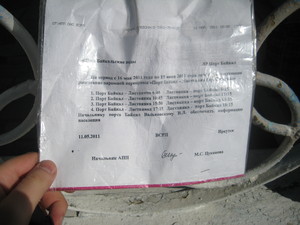 Port Baikal is really small. It wasn't even possible to get a coffee there, it only has some small shops (where we got some very good baked sweets). It is the starting point of the circum baikal railway line. We had to stay several hours, because the ferry only goes a few times a day. Port Baikal gave us a feeling of seeing Russian live in a small village. Some cows were just walking on the "streets" (no paved roads here). I assume Port Baikal has no water supply, as many people were getting water from a pump near the train station.
Port Baikal is really small. It wasn't even possible to get a coffee there, it only has some small shops (where we got some very good baked sweets). It is the starting point of the circum baikal railway line. We had to stay several hours, because the ferry only goes a few times a day. Port Baikal gave us a feeling of seeing Russian live in a small village. Some cows were just walking on the "streets" (no paved roads here). I assume Port Baikal has no water supply, as many people were getting water from a pump near the train station.Pictures from Listwjanka
Pictures from Port Baikal
Irkutsk
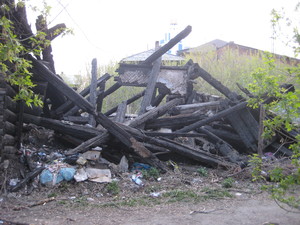 I'm still lagging behind a lot with blogging my trip. So I'll try to keep up a bit.
I'm still lagging behind a lot with blogging my trip. So I'll try to keep up a bit.After Yekaterinburg and a more than two day long train trip, we arrived in Irkutsk (Иркутck) near lake Baikal. Irkutsk is a much more tourist dominated city, which you suddenly notice by the larger number of english speaking people.
What I found noteworthy: At the beginning of our trip, I didn't see much of extreme poverty. This changed in Irkutsk. Large parts of the city are very small houses often in very bad shape. There are very rough breaks - in the same street, you see very modern buildings and a few meters further you see barracks. Also, there were a lot of burned down houses.
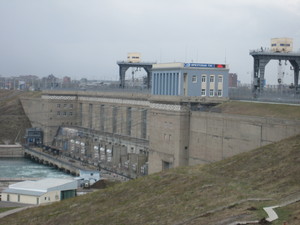 I took the opportunity in Irkutsk to visit the water power plant. It seems not many people consider it an interesting sight, as i was completely alone when I walked on and beside the dam.
I took the opportunity in Irkutsk to visit the water power plant. It seems not many people consider it an interesting sight, as i was completely alone when I walked on and beside the dam.A nice thing to visit was the market in Irkutsk, however, one should be prepared to be spoken to permanently by people trying to sell something to you.
After a short stay in Irkutsk, we went on to lake Baikal and the village Listvijanka (Листвянка).
Pictures from Irkutsk
Pictures from water power plant and dam in Irkutsk
Saturday, May 21. 2011
The Trans-Siberian Railway
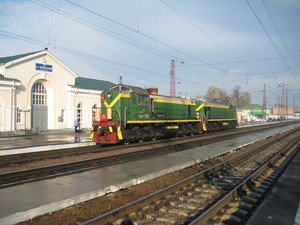 Large parts of our trip to Asia is on the famous Trans-Siberian Railway. It goes from St. Petersburg in the north-west of Russia to Vladivostok in the far south-east and has several sideways like the Trans-Mongolian line and the Trans-Mandshurian line to China. I started my Transsib-trip in Moscow and am currently in Ulan-Ude (Улан-Удэ).
Large parts of our trip to Asia is on the famous Trans-Siberian Railway. It goes from St. Petersburg in the north-west of Russia to Vladivostok in the far south-east and has several sideways like the Trans-Mongolian line and the Trans-Mandshurian line to China. I started my Transsib-trip in Moscow and am currently in Ulan-Ude (Улан-Удэ).Travelling in middle-Europe, one is usually not used to several-day long train tips. On our trip, we used only Platzkart (плацкарт), which is the 3rd and cheapest class which has a bed (on some parts you can get seat only tickets, which are even cheaper, but we always travelled over night, so this was no suitable option). Platzkart means that you're not travelling in small compartments, the whole carriage is one compartment with several beds in it. Although we read in several travelling guides that it's an uncommon option for European travellers, we found it quite satisfying.
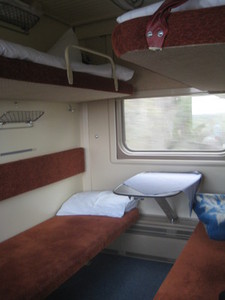 Every carriage has usually two train conductors. Something common on russian trains is that you can always get hot water to make tea or packet soup. I read in advance that there are a lot of food facilities on the stations, but this turned out to be much less of an option than thought. There are usually only small kiosks which all have more or less the same offerings.
Every carriage has usually two train conductors. Something common on russian trains is that you can always get hot water to make tea or packet soup. I read in advance that there are a lot of food facilities on the stations, but this turned out to be much less of an option than thought. There are usually only small kiosks which all have more or less the same offerings.Our longest train-trip was from Yekaterinburg to Irkutsk, which took us more than two days. It was very exhausting and we plan to avoid any more train trips longer than 24 hours for the rest of our journey. We also had some unpleasant experiences with drunken fellow passengers.
Pictures from Train Yekaterinburg - Irkutsk
Update: What I forgot to mention that's very noteworthy: On our trip, the transsiberian train was always very sharp on its schedule, at maximum it was only minutes behind. Very remarkable for several day long train trips.
Monday, May 16. 2011
Yekaterinburg
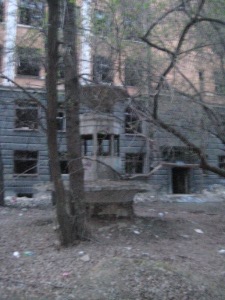 I am a bit behind with blogging my trip - not enough time, and if there's enough time, theres often not enough electricity or internet.
I am a bit behind with blogging my trip - not enough time, and if there's enough time, theres often not enough electricity or internet.We stayed for two days in Yekaterinburg (Екатеринбу́рг), which is the first big asian city if you travel from Europe to Russia. Yekaterinburg is probably a place where international visitors rarely drop by.
We stayed at two couchsurfers who operate a vegetarian shop in an area where vegetarism is barely known at all. So if you are ever in Yekaterinburg and need some tofu or soy milk, be sure to visit their shop.
The most relevant and unpleasant event during our stay was our attempt to get a ticket for our further route. I first thought that this wouldn't be a big issue, as we can order online tickets. But, as I already mentioned before, this is not an option here. For reasons unknown to me, this only works if you board the train at its starting point. So we went to the train station to try to get a ticket. Without much knowledge of Russian language, this was a really tough task and took us several hours. We wrote down the train we wanted to take and some Russian sentences we took from a travel guide. We were sent from one counter to the other, several times the ticket counter closed or made a "15 minute" pause (which in fact were more like 45 minutes) just in front of us. All in all I don't really know when we started this, so I don't know how long it took, but after all, we had the tickets we wanted in our hands - and they were significantly cheaper than any online offer we saw.
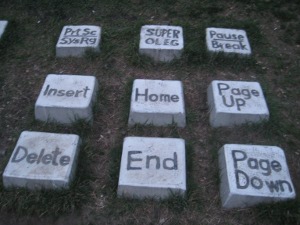 Beside the ticket buying, which took us half a day and limited the time we had to see the city, some interesting places worth mentioning:
Beside the ticket buying, which took us half a day and limited the time we had to see the city, some interesting places worth mentioning:- Yekaterinburg has a very geekish sight: A keyboard monument (some websites like Wikitravel call it the QWERTY monument, but I don't know if that's its official name) - a big keyboard made of stones (map link).
- We were shown an old hospital that was closed about 10 years ago and is now a place where adventurous people do urban exploration and locals tell horror stories about hidden subfloors. Most of the building is in very bad shape and some fountains around it give it a very special atmosphere. A small part of the building however is still operational (I don't know the exact place, but it must be around here).
A common thing to see in Yekaterinburg are trolley busses - busses that uses overhead wires.
What I experienced the first time here was a kind of real-world spam that seems to be common in Russia: In the pedestrian area, many shops used sound systems for advertisement. So you hear a lot of music and loudspeakers telling you the latest cheap offers all the time. Very disturbing.
We've continued our trip to Irkutsk, but I'll write about that later.
Pictures from Yekaterinburg
Wednesday, May 11. 2011
From Moscow to Yekaterinburg
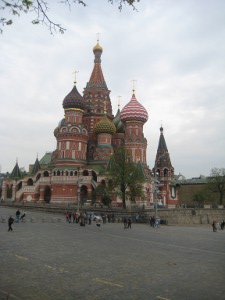 After a 30 hour train trip, we arrived at Moscow Belorussky Terminal (Москва́ Белорусский вокзал). We stayed with some very nice Couchsurfers.
After a 30 hour train trip, we arrived at Moscow Belorussky Terminal (Москва́ Белорусский вокзал). We stayed with some very nice Couchsurfers.We stayed in Moscow for about two days. It'll mainly leave me with two impressions. First, Moscow is the most car-dominated city I've ever been (I've always considered Stuttgart and Berlin to be very car-dominated, but it doesn't compare). Big roads everywhere, loud and smoggy.
We stayed in Moscow at the 9th may, which is the most important holiday in Russia. It is the day that is known in middle europe as the 8th may due to timezone shift - the day the red army finally defeated Nazi-Germany. Since a few years, in Moscow there's a big military parade, which ends with a presentation of Russia's nuclear missiles. It gave me very mixed feelings. It's probably the best reason to celebrate that one can think of, though it seems wrong to me to celebrate nuclear missiles.
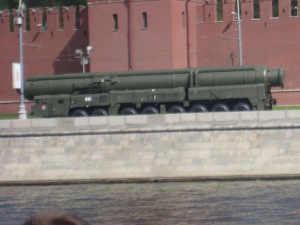 I read a lot that it's difficult for foreigners without russian language skills to get tickets at the station's offices. The offers you'll get if you book through travel agencies in Germany are usually totally overpriced and it's often impossible to book the 3rd class at all. We booked our tickets through Real Russia, a UK-based company selling tickets online. It's webpage is very useful, you can check train tables, fares and free space. We had no need to go anywhere or get the tickets via mail, as they just register our passport number and the train staff has a list with them, so your passport is your ticket. However, it seems this only worked for the first train and they don't offer that for the further trains.
I read a lot that it's difficult for foreigners without russian language skills to get tickets at the station's offices. The offers you'll get if you book through travel agencies in Germany are usually totally overpriced and it's often impossible to book the 3rd class at all. We booked our tickets through Real Russia, a UK-based company selling tickets online. It's webpage is very useful, you can check train tables, fares and free space. We had no need to go anywhere or get the tickets via mail, as they just register our passport number and the train staff has a list with them, so your passport is your ticket. However, it seems this only worked for the first train and they don't offer that for the further trains.Then we headed for the first part of the Transsiberian Railway - a 25 hour trip to Yekaterinburg (Екатеринбу́рг). While you can read in many travel guides that middle european tourists usually don't travel in the 3rd class, I was positively surprised by the quality. Everything was clean and nice. The only drawback: The bed was a bit short for my long legs. Luckily, I had the opportunity to get some more hours of sleep in a bed with an open end. Language was difficult: It seems nobody on the train was able to speak English or German. Everything went smooth, so there was no need for communication, but it may become difficult when problems arise.
While we're at it, a nice weblink: Google has the full transsiberian route on video with a map showing where you are.
Now we're in Yekaterinburg, shortly after the european-asian border. My first time in Asia.
Pictures from Moscow
Pictures from Berlin-Moscow train trip
Friday, May 6. 2011
To Asia with the train
Map by OpenStreetMap, CC by-sa
Beside finishing my studies, the last months were filled with preparations for the trip. Getting a proper bag, deciding what to take and what not, vaccinations and getting all the Visa ready - which was the most tiring part, maybe I'll write in detail about that later.
I hope I'll find time to write some blogposts and post pictures (you'll find them here as soon as I made some).
Wednesday, May 4. 2011
Diploma thesis on RSA-PSS finished
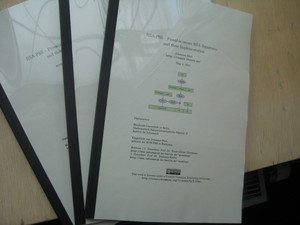 Today I submitted my diploma thesis to my university.
Today I submitted my diploma thesis to my university.The thesis summarizes several months of investigation of the Probabilistic Signature Scheme (PSS). Traditionally, RSA signatures are done by hashing and then signing them. PSS is an improved, provable secure scheme to prepare a message before signing. The main focus was to investigate where PSS is implemented and used in real world cryptographic applications with a special focus on X.509.
During my work on that, I also implemented PSS signatures for the nss library in the Google Summer of Code 2010.
The thesis itself (including PDF and latex sources), patches for nss and everything else relevant can be found at
http://rsapss.hboeck.de.
Monday, May 2. 2011
DIY recycling: High quality magnets from harddisks
 I have a magnet plate hanging over my desk. Usually, the normal magnets for that purpose you can buy in shops are of very low quality and not very strong and fail to hold more than a few pieces of paper.
I have a magnet plate hanging over my desk. Usually, the normal magnets for that purpose you can buy in shops are of very low quality and not very strong and fail to hold more than a few pieces of paper.I recently discovered a way to get much better magnets almost for free: From old harddisks. To open a harddisks, you will usually need some kind of Torx screwdriver. Inside, you will find one or two very strong neodym magnets, which were originally used to move the read head.
Posted by Hanno Böck
in Computer culture, Ecology, English, Life
at
17:24
| Comments (0)
| Trackbacks (0)
(Page 1 of 1, totaling 11 entries)
